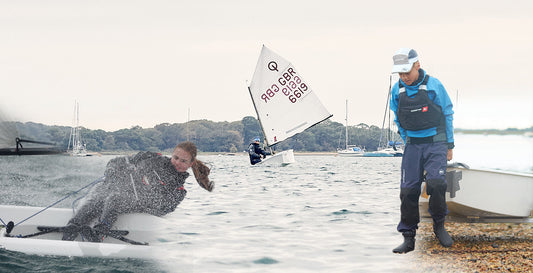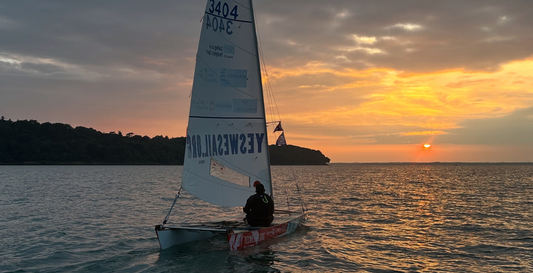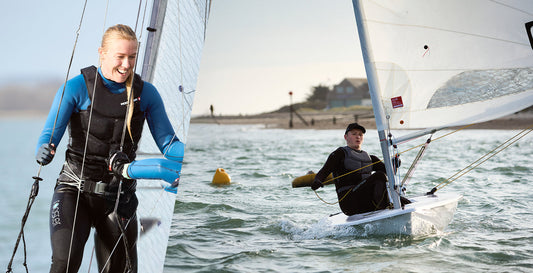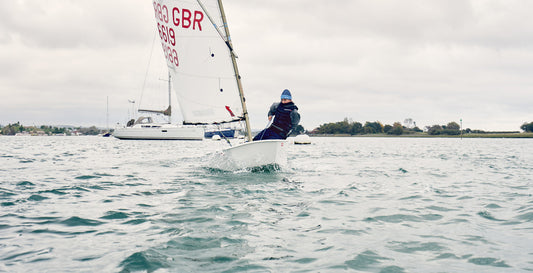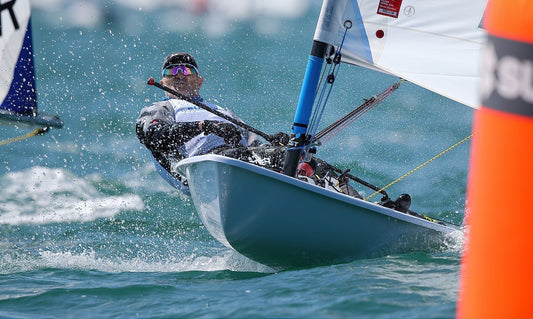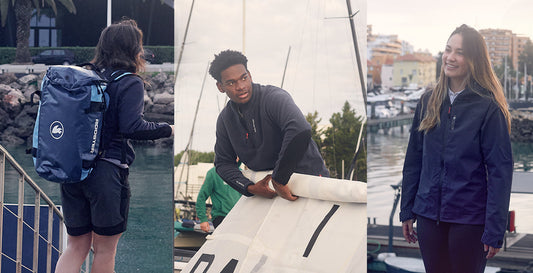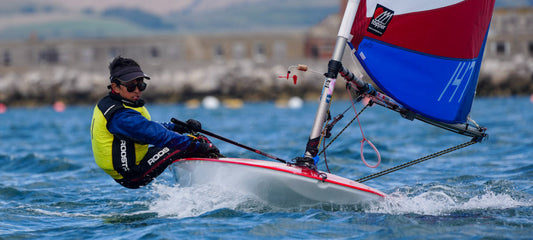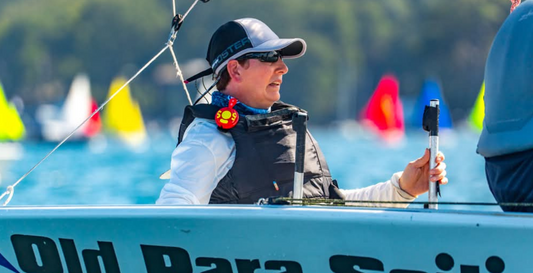
THE ROOSTER BLOG
Discover tips, tricks and stories from the Rooster team and guest writers.
Latest Entries
Sandy Point x Rooster: New bags added for the 2025 Gifting Season
Two years ago, we teamed up with Sandy Point — a small local business just down the road from Rooster HQ — to launch a limited-edition run of repurposed sailcloth bags for Christmas 2023. What started as a one-off festive collaboration quickly became something much bigger.
You loved the bags, you loved the story, and the idea of giving sails a second life.
So instead of ending with the holiday season, the Sandy Point Collection kept sailing on.
And now, for the 2025 gifting season, we’re excited to share that the range has grown again, with four brand-new bag styles and new colour options added to the original favourites.
Why repurposed sails?
Sails lead hard-working lives. They’re exposed to sun, salt, strain, and endless days on the water. Once they’ve reached the end of their performance life, they’re notoriously difficult to recycle and often end up with no real afterlife.
That’s where Sandy Point comes in.
Together, we’ve created a way to turn these materials into practical, long-lasting bags — each one with a story stitched into the fabric.
Every Sandy Point bag includes a small internal label telling you exactly which sail it was made from. It’s a nod to where the material came from and a reminder that nothing goes to waste.
Meet Rory from Sandy Point
Rory is the hands-on sailor and between him and his team at Sandy Point Chandlery, they are the makers behind every bag. He’s the guy who knows his way around knotted lines, splicing, and the finer details of ropework — and he’s as laid-back as they come.
Here’s what he had to say about the latest collection:
“Working with Rooster has been a really natural fit for us. These sails have already spent a lifetime doing what they were built for, so giving them a second purpose feels spot on. Every bag still carries a bit of that history in the cloth, and that’s something I love about the process — nothing goes to waste, and the story doesn’t stop. Seeing the collection grow just shows that people appreciate gear that’s made properly and built to last.”
What’s new this season?
We’ve added four new styles to the Sandy Point line-up — designed for everyday life, whether you’re heading to the boat park, commuting, travelling, or spending the day on the coast:
A5 Sailcloth Wallet – perfect for travel documents, small tech, and daily essentials.
A4 Sailcloth Wallet – ideal for notebooks, tablets, and keeping things organised on the go.
Sailcloth Coin Purse – small, tough, and sized for cards, cash, keys, or pocket items.
Premium Beach Bag – a roomy, hard-wearing beach companion with rope handles, stainless hardware, a water-resistant base, and a zipped internal pocket.
You’ll also find fresh colour variations across the original styles — inspired by Rooster’s coastal heritage.
The Sandy Point Collection has always been about more than bags. It’s about supporting local craft, reducing waste, and making better use of materials that still have plenty of life left in them.
By working with a local maker and giving retired sails a new purpose, it’s good to show how technical materials can become durable, everyday gear without compromising on practicality or design.
The 2025 Ultimate Gift Guide
Looking for the perfect gift for the sailor in your life?
Whether they’re out in all weathers, just starting their sailing journey, or living for those crisp winter training sessions, our Christmas Gift Guide brings together the best Rooster kit for every type of sailor. To make it even easier, we’ve added a simple icon guide—think Warmth, Waterproof, Travel, Beginner-Friendly and Budget—so you can match your search to exactly what they need. From smart stocking fillers to performance essentials, you’ll find gifts they’ll genuinely love (and actually use) on the water.
Give the All-Weather Warrior something that works as hard as they do. These gift ideas are all about serious warmth and protection—reliable, storm-ready kit that keeps them sailing comfortably through whatever the forecast throws their way.
Pro Aquafleece Top, Aquafleece Beanie, Hot Socks, Hot Hands
Christmas is all about the kids! For the Young Sailor in your life, think gifts that fuel their excitement for every launch and landing. These picks are fun, durable and confidence-boosting—perfect for keeping them warm, comfortable and ready to learn on the water.
Junior Overhead Buoyancy Aid, Aquafleece Neck Gaiter, Junior Microfibre Quick Dry Poncho, Combi Gloves
Treat Your Biggest Fan to something that says thank you for all those early mornings and long waits. These gifts are practical, cosy, and thoughtful—perfect for keeping them comfortable while they cheer you on from the shore.
Pro Aquafleece Rigging Coat, Aquafleece Robe, 35L Dry Back Pack, Sports Drink Water Bottle
Find something special without stretching your wallet with our Under £25 picks. Perfect as stocking fillers or little treats, these gifts are fun, useful, and sure to bring a smile to any sailor’s face.
Rooster Cap, Aquafleece Headband, 10L Drybag, Joey Water Bottle Holder
Discover our Under £100 gift picks—great for giving a little more without going overboard. These thoughtful, high-quality pieces are perfect for sailors who appreciate gear that’s both practical and a treat to unwrap.
35L Dry Backpack, Poly Pro Top, Changing Mat Bag, Microfiber Quick Dry Poncho
For The One That’s Always On the Go, give gifts that make life on the move easier and more enjoyable. From compact, travel-friendly gear to clever kit that packs a punch, these picks keep them ready for every adventure on and off the water.
50L Semi-Dry Duffel Bag, Sports Drink Water Bottle, 90L Carry All Bag, Shoreline Jacket
For Dinghy Sailors, choose gifts that match their love of speed, skill, and adventure on the water. From performance essentials to clever accessories, these picks make every launch, tack, and capsize a little more fun and a lot more comfortable.
Knee Pads, Pro Laced Boots, Pro Lite Aquafleece Top, 60L Dry Bag
For Keelboat Sailors, find gifts that enhance their time on deck and make every voyage smoother. From durable kit to handy accessories, these picks combine practicality with comfort for long days on the water.
SB1 Inshore Dry Smock, SB1 Inshore Jacket, SB1 Inshore Hi-Fits, 50L Semi-Dry Duffel Bag
For Last-Minute Shoppers, don’t panic—we’ve got your back! A Rooster gift card lets them choose exactly what they need, making it the perfect easy, stress-free present that still feels thoughtful.
Rooster Gift Card
No matter who you’re shopping for, there’s something in our Rooster Christmas Gift Guide to make every sailor smile. From stocking fillers to performance essentials, practical gear to travel-friendly treats, you’ll find gifts that are thoughtful, useful, and ready to bring joy both on and off the water.
Junior Winter Kit: How to Keep Young Sailors Warm This Season
When the temperature drops, sailing doesn’t have to stop. With the right layers and smart kit choices, winter sailing can be just as rewarding as summer — sometimes even more so. For junior sailors, learning how to stay warm and dry on the water is a key part of growing in the sport.
At Rooster, we’ve spent years developing kit that works as hard as the sailors wearing it — gear that keeps young sailors confident, comfortable, and ready to face the chill head-on.
Why the Right Winter Kit Matters
Cold conditions can make or break a training session. It’s hard to focus on racing tactics or boat handling when you’re distracted by numb fingers or shivering. Proper layering helps young sailors stay safe and comfortable — and most importantly, enjoy every moment on the water.
Rooster Rider Amelie Ballantyne puts it best:
“Once you’re warm and dry, everything changes. You can focus on sailing — not surviving. My top tip is to block the wind BEFORE you get wet. Wind chill is your number one enemy and it’s hard to warm up if you’re already cold and wet. I always wear my Pro Aquafleece Top to keep warm"
What Our Riders Recommend
We asked our Rooster Riders to share their top layering tips for winter sailing — the things they wish they’d known before their first cold session.
Their advice all points to the same truth: getting layering right means you’ll stay on the water longer, sail better, and have more fun.
The Junior Winter Kit System
Here’s a simple layering setup our Riders swear by:
1. Base Layer – Polypro or ‘Hot’ Top & Leggings
A warm, stretchy yet thin foundation that regulates body temperature without restricting movement.
2. Mid Layer (Wetsuit layer) – Supertherm 4mm Longjohn and Top
The powerhouse of your winter kit. Neoprene creates a dynamic thermal barrier by trapping a thin layer of water and maintaining your core temperature, all while offering stretch and freedom of movement for active sailing.
3. Outer Layer – Aquafleece Spray Top
Your essential weather shield, perfect for throwing on over your base. Protects against spray, rain, and wind chill — keeping core warmth in and water out.
4. Accessories – Gloves, Boots, and Hats
Often underestimated but crucial. Warm extremities = happy sailor.
Shop Junior Winter Kit
Layer up, Sail on…
Great kit doesn’t just keep you warm — it builds confidence. When juniors can focus on their technique rather than the temperature, they develop faster, stay positive, and actually look forward to those early winter starts.
That’s what we love to see at Rooster — young sailors who are comfortable, capable, and ready to take on any conditions.
Explore our Rider-approved winter essentials for junior sailors and help your sailor stay warm, dry, and ready for every challenge this season.
Read more about the right layers for you on our Layering Guide
Redefining Limits: My Journey to Sail Solo Around the Isle of Wight Blind
Written by Dani Anglada Pich
Who I Am
My name is Dani Anglada Pich. I was born in Barcelona in 1986, and the sea has been part of me for as long as I can remember. I first set sail at the age of six in dinghies, and from that very moment I knew: this was where I felt alive. The sound of the wind, the balance of the boat, the salt on my skin—it was home.
At twenty, I was already skippering the ex-Fortuna Light, Spain’s entry in the 1986 Whitbread Round the World Race. That boat carried the spirit of ocean adventure, and being at her helm pushed me to dream even bigger.
Later I studied at the Nautical Faculty of Barcelona, Polytechnic University of Catalogne, becoming a merchant marine officer. My life was all about the sea. And then, in 2018, everything collapsed. An accident on board a merchant vessel left me totally blind.
The first years were brutal. I’ll be honest—I felt like I had lost myself as well as my sight. But slowly, step by step, the sea pulled me back. With rehabilitation, with my family and friends beside me, with professionals and foundations who believed in me, I rebuilt myself. I learned to live again. And more than that—I chose to keep sailing.
In 2024, I founded Yes We Sail, both an association and a start-up, to prove that the sea belongs to everyone, especially those who are told they “can’t.” Sailing became my way of life again, but also my mission: to show that limits are not walls, they are just horizons waiting to be crossed.
Why I Took on the Challenge
Less than a year before the challenge, I said out loud: “I want to sail solo around the Isle of Wight.” At the time it sounded crazy—even to me. But I knew it had to mean something more than just sailing.
During the 37th America’s Cup in Barcelona, I had the support of the organisation and the unconditional encouragement of Grant Dalton. Grant embodies what the Cup is about: perseverance, effort, resilience. I wanted to honour that support. And where better than the Isle of Wight—the very waters where the Hundred Guineas Cup was sailed in 1851, the race that would later become the America’s Cup, and the stage for regattas like the Admiral’s Cup and Cowes Week.
To attempt this circumnavigation blind, in a Patí a Vela—a boat with no rudder, no centreboard, no boom—was my way of tying history to the present. A way to say: the sea is for everyone. And a call: bring sailing back to the Paralympic Games in Brisbane 2032.
Preparation: From Dream to Voyage
To make this real, every detail had to change. My boat, Lady, a Patí a Vela, was built with tactile textures on deck so I could “read” her with my feet and hands. Every rope had a unique feel, so I knew it instantly. I wore a haptic vest that pulsed vibrations for waypoints and wind direction. I studied 3D maps of the island until I could imagine the tides and currents in my head as clearly as if I had seen them with my eyes.
Training in Cowes was intense. The East Cowes Sailing Club opened their doors to me—their slipway, their trust, even their friendship. Magnus Wheatley gave tactical advice, and engineers, volunteers, and sponsors all turned a fragile idea into something seaworthy. And
Lady, built two years earlier with a master boatbuilder and myself, became more than a boat: she was my voice, my balance, my partner.
The Odyssey Around the Island
24 July 2025, 08:01. The cannon of the Royal Yacht Squadron fired. I set off. The first stretch to The Needles was pure joy—12 knots of speed, wind NNW 10–15, and I could feel Lady fly.
Then, silence. At Freshwater Bay the wind dropped, and I had to push eight miles offshore into the Channel to find a breath of air. It took over five hours to reach St Catherine’s Point, sailing downwind with under 10 knots and rolling waves. The Patí doesn’t like that course—it felt unstable, restless under me.
Past the lighthouse, the sea flattened, a NE breeze came in at 12 knots with gusts to 18. For a moment, I thought finally, easier. I was wrong.
After nine hours at sea, past Ventnor and Sandown Bay, came the real trial. The tide turned at low water. Chaos. Gusts slammed up to 28 knots. The hull creaked, the mast groaned, and I thought: What am I doing here, risking everything?
But I stayed. I listened. I focused. I trusted the protocol I’d spent four years building. The Patí speaks if you pay attention—through vibrations, through the surge of the hull, through whispers in the rig. Step by step, I fought on. Thirteen tacks. Twice I was thrown to the deck, struggling to get her steady again. But I carried on.
By sunset, I was spent. Exhaustion, cold, pain. The last miles to Cowes weren’t a fight with the sea—they were a fight with myself. I trimmed the sail, so I didn’t have to move, and locked my focus on the wind, the tide, the rhythm of the boat.
The Finish Line
Finally, the tide lifted me, a soft breeze carried me home. Crossing the line wasn’t the victory I had imagined—it was survival. It was release. It was rebirth.
I collapsed on deck, overwhelmed, and kissed Lady for all she had endured, for bringing me back safe. Two years earlier, with a master boatbuilder, I had begun shaping her. Now, whole and unbroken, she had carried me to harbour. In that moment, I felt nothing but honour. She wasn’t just a boat—she was my companion, my sight, speaking to me mile after mile until we made it home together.
Reflections: What the Sea Taught Me
That day I lived everything: calm and storm, fear and joy, despair and triumph. Times when I doubted. Times when I felt free beyond words. By the end, it all exploded inside me—sadness, pride, exhaustion, happiness, strength.
I realised this: what we call limits are often just perceptions. The sea strips you down until only truth remains. And with preparation, courage, and passion, you can go further than anyone ever thought possible.
Gratitude
None of this would have been possible without those who believed. My deepest thanks to the East Cowes Sailing Club, to Magnus Wheatley, to every volunteer, to my sponsors, and especially to Rooster. The technical clothing and equipment they provided protected me to the very last wave. But more than gear, they gave me something priceless: belief. Belief in people, in dreams, and in the idea that sailing belongs to everyone.
And a very special mention to my main sponsor, Port Masnou and Club Nàutic El Masnou. They’ve been with me from the very start—not only supporting this challenge but building the future of inclusive sailing. They opened their facilities, shared their coaching, and stood behind Yes We Sail with trust and commitment. Without them, this dream would never have left the shore.
Closing Message
To anyone who doubts themselves: remember this. Disabilities are not limits. They are different abilities, different perspectives, different strengths.
If I, without sight, could sail solo around the Isle of Wight, then you too can face your seas—whatever form they take.
This was more than a challenge. It was the beginning of a new horizon: a call for inclusive sailing, for courage, and for the will to believe again.
Why Upgrade to a 4mm Wetsuit for Winter Sailing?
Winter sailing can be some of the most rewarding time on the water — crisp mornings, steady breezes, quieter waters. But with colder conditions comes one big challenge: staying warm. Your wetsuit is your first line of defence, and choosing the right thickness is critical. Here’s why upgrading to a Supertherm 4mm wetsuit can transform your cold-weather sailing experience.
Quick Look:
1. How Neoprene Keeps You Warm
Neoprene works by trapping a thin layer of water between your body and the suit. Your body heats this water, creating an insulating barrier. The thicker the neoprene, the more insulation it provides — making it much harder for heat to escape.
2. Why Thickness Matters
1.5mm neoprene (like our Thermaflex) offers flexibility and comfort for mild to warm conditions.
4mm neoprene (like the Supertherm) adds serious insulation for cold-weather training, helping you retain heat for longer sessions.
Think of it like the difference between a light jacket and a winter coat — both have their place, but when the cold bites, you’ll want the thicker layer.
3. Advanced Linings for Extra Warmth
The Supertherm 4mm range isn’t just thicker — it’s smarter. Enhanced linings wick moisture away from your skin, add thermal comfort, and dry faster between sessions. That means less of the “chill factor” when you put your wetsuit back on for the afternoon race.
4. The Role of Stitching: Flatlock vs GBS
Not all seams are created equal.
Flatlock stitching (used in thinner suits like Thermaflex) is breathable but allows small amounts of water through — fine for warmer sailing.
GBS (Glued and Blind Stitched) seams, used in all our Supertherm range, are sealed to minimise water entry. This keeps the insulating layer of water more stable and your body much warmer.
5. Designed for Winter Performance
Sailors often assume thicker neoprene means restricted movement — not with Supertherm. Our panels are engineered for stretch and flexibility where you need it most, so you stay agile and comfortable while still benefiting from maximum warmth.
6. Pairing with Other Layers
The Supertherm range is built to be part of your complete winter system. Layer it up with:
· Thermal base layers like our Polypro or Hot tops & leggings — not only do they help manage moisture, but they also add an extra insulating layer, trapping air and boosting warmth.
· Spray protection such as the Aquafleece® or SB1 Inshore Dry Smock — your outer defence against wind and water.
Together, these layers create a system that locks in heat, keeps you dry, and stands up to whatever winter sailing throws at you. Read more about layering by visiting our Layering Guide.
Don’t let the cold hold you back. With the right wetsuit, winter sailing can be just as enjoyable — if not more — than the summer season. Our Supertherm 4mm range is designed to give you the warmth, comfort, and performance you need to sail on through the colder months.
Winter Training Layering Tips
Winter doesn’t mean your sailing or training has to stop – it just means you need to prepare your kit properly. The right layering system will keep you warm, dry, and able to focus on performance instead of the cold. At Rooster, we’ve refined our layering philosophy so every piece works together, giving you flexibility whether you’re racing, coaching, or training ashore. You can check out our full layering guide for tips throughout the year, but for Autumn/Winter specific keep reading below:
The Golden Rule: Layer Like an Onion
Layering is about trapping warm air close to your body while managing moisture and protecting against wind and spray. Each layer has a job to do, and when combined, they deliver comfort and performance in even the harshest conditions.
Think of this as your second skin. Its job is to regulate body temperature and wick moisture away, keeping you dry even when you’re working hard.
Technical base layers: Soft, quick-drying fabrics prevent chills caused by sweat.
Close-fitting design: Ensures no cold gaps and allows easy layering on top.
Rooster Pick: Hot Top & Leggings – the winter sailor’s secret weapon.
Top tip: Skip rash vests or Lycra layers as insulation – they won’t add warmth and can actually make you feel cooler. When it comes to layering, sometimes less really is more.
This is where you add warmth. Choose pieces that are flexible, breathable, and easy to peel off when conditions change.
Flexible layering: Adjust your neoprene thickness to match the forecast. When the temperature drops below 15°C, reach for your Supertherm® 4mm Top and Longjohn for maximum warmth. In milder conditions, your Thermaflex® 1.5mm layers may be all you need – and if you’re someone who feels the cold, add extra base layers for comfort. When it is really really cold, you could double up on neoprene!
Check out our blog on what the forecast says vs the actual temperatures.
Your shell is the barrier against wind, spray, and rain. Look for waterproofing, breathability, and freedom of movement.
Aquafleece Spray tops or SB1 Inshore Smock: Great for dinghy sailing.
SB1 Jacket or Pro Rigging Jacket: Added protection when conditions are rougher.
Your hands, feet, and head lose heat fastest, so finishing your system with quality accessories is vital.
Neoprene gloves & mitts for grip and warmth.
Neoprene socks layered under boots for warm, dry feet.
Hats, beanies, neck gaiters & balaclavas to prevent heat loss from your head and neck.
💡 Did you know? Research published in the British Medical Journal found that if your head is the only part of your body uncovered, you can lose around 7–10% of your body heat through it. A simple hat or hood can make a huge difference to your comfort and endurance on the water.
Customer Favourite Pick for Autumn/Winter Training: AquaPro Gloves, Hot Socks, Supertherm Beanie & Aquafleece Neck Gaiters.
One of the toughest parts of winter training is when the day is split into two sessions with downtime in between. That mid-day break can be when the cold really creeps in, leaving you feeling flat, sluggish, and unmotivated for round two. The good news? With a few smart habits, you can stay warm, recover properly, and head back out ready to perform.
Top tips for staying warm between sessions:
Layer up quickly: Throw on a warm, windproof outer layer such as our Pro Aquafleece® Rigging Coat or Aquafleece® Robe to trap heat and stop the chill setting in.
Swap your kit: Take a spare pair of socks and gloves to change into during the break – dry, warm hands and feet make a huge difference.
Don’t forget your head: A simple beanie helps keep body heat in and makes you feel instantly warmer.
Refuel smartly: Pack proper food and a hot drink to top up energy levels and keep your core temperature steady.
Keep moving: Light activity between sessions helps circulation and stops you from cooling down too much.
Avoid rash/lycra layers – they hold water and makes you cold.
Stay flexible – pack an extra mid-layer, socks and gloves in your kit bag so you can adapt.
Check your fit – layers should sit comfortably without restricting movement.
Look after your gear – rinse saltwater off regularly and let items dry fully.
Final Thought: Winter sailing and training are all about preparation. Get your layering right, and you’ll be warm, comfortable, and ready to perform – whatever the weather throws at you.
Our full layering guide and more information on layering for different conditions can be found here
Steve Cockerill explains: 'Follow-on' ILCA Training
My favourite training routine for small to medium sized groups is a ‘Follow-On’.
Rooster Autumn 2025 Collection | New Duffel Bag, Jackets, Fleece & Sunglasses
Autumn is a season of change — cooler mornings, shorter days, and crisp conditions on and off the water. It’s also the time when the right layers and reliable kit make all the difference. For the Autumn 2025, we’ve launched a brand-new line-up designed to keep you ready for whatever the season throws your way: the 50L Semi-Dry Duffel Bag, the Shoreline Jacket, the Polartec® Fleece, and Polarised Sunglasses.
Whether you’re heading to training, commuting, or escaping to the coast, these new arrivals are built to perform across every part of your lifestyle.
NEW IN:
When it comes to transporting kit, durability and reliability are key. The new 50L Semi-Dry Duffel Bag has been designed to handle the demands of everyday use and weekend adventures.
50-litre capacity: spacious enough for sailing kit, gym gear, or a weekend away.
Semi-dry construction: water-resistant materials keep contents protected from spray and showers.
Built to last: rugged fabrics and reinforced details ensure long-term reliability.
It’s the ideal bag for the sailor, coach, or anyone who wants one solution for their kit, wherever they’re headed.
👉 [Shop the Duffel]
The Shoreline Jacket brings together performance and versatility. Designed to bridge the gap between watersports protection and everyday practicality, it’s a lightweight, breathable jacket you can wear almost anywhere.
Water-resistant and breathable for comfort in unpredictable conditions.
Lightweight design makes it easy to wear on its own or over a fleece.
Everyday style that looks just as good on a coastal walk as it does on the daily commute.
It’s the kind of jacket you’ll keep by the door, ready for whatever the day brings.
👉 [Shop the Shoreline Jacket]
A dependable fleece is a year-round essential, but it really comes into its own in autumn. Our new Polartec® Fleece delivers premium warmth without bulk, making it perfect as a standalone piece or a layering option under waterproofs.
Made with Polartec® fabric for trusted quality and performance.
Warm yet lightweight, so you stay comfortable without overheating.
Versatile fit that works on the water, at the club, or in everyday use.
It’s practical, comfortable, and built to last — everything you need from a mid-layer.
👉 [Shop the Polartec Fleece]
Autumn brings low sun and dazzling glare, especially around the water. Our Polarised Sunglasses are designed to protect your eyes and improve visibility in these conditions.
Polarised lenses cut through glare and sharpen detail.
Lightweight and durable frames for all-day comfort.
Essential protection for training, coaching, or time outdoors.
They’re a small piece of kit that makes a big difference to comfort and performance.
👉 [Shop Sunglasses]
Ready for Autumn Adventures
From the tough new duffel bag to versatile layers and glare-cutting sunglasses, this 2025 collection has been designed with durability, comfort, and practicality at its core. Whether you’re preparing for time on the water, long coaching days, or simply making the most of crisp autumn weekends, this kit is built to move with you.
👉 [Explore all New 2025 Collection]
Sailing Sideways: How To Become A Double World Champion In Different Boats
This summer, I was lucky enough to win the Tera Sport World Championships, surprisingly making me the first person to be a double World Champion in both a Topper and a Tera.
Hansa World Championships: The Importance of UV Protection on the Race Course
Blog written by Kirsten Pollock, SKUD18 Sailor
Hansa are the largest manufacturer in the world of sail boats used by people with disabilities. The boats are designed to a Universal principle, with weighted keels, that allows anyone, whether young, old, able or with a disability to sail easily and safely, making sailing a very equal and inclusive sport.
Every two years the five Hansa Classes come together for an International and World Championships. The boats are named by metric size, the smallest is the 2.3, then 303 divided into one and two-person fleets, the larger Liberty and finally the fast and powerful Paralympic SKUD18.
The 2025 Hansa Worlds took place at Pittwater, near Sydney, Australia. Sixteen nations, with competitors from Australia, Chile, France, Germany, Great Britain, Hong Kong, Italy, Japan, Netherlands, New Zealand, Poland, Portugal, Singapore, South Korea, Spain and USA took part and, representing Great Britain in the SKUD Class, was me, crewed with top local sailor Brett Pearce who was Australian Reserve Crew for the 2016 Paralympics in Rio. Other illustrious names in the fleet were Dan Fitzgibbon, three times Paralympic Medallist, plus Asia Pacific SKUD Champion Neil Rowsthorne.
The Rooster clothing was brilliant, especially the long sleeved UV top, neck sleeve and cap helped protect me and my crew from the sun. I have fair skin and burn very easily so having the right clothing especially in strong UV conditions makes all the difference. I could focus on sailing rather than having to contend with sunburn etc.
After the regatta I went travelling and Rooster were with me every step or wheel of the way. I spent a few days in central Sydney. I then went to Uluru, from there I went to Port Douglas and went to the Barrier Reef, I wore Rooster kit in the water to protect me from the UV rays. I then went to Melbourne.
My Rooster kit proved to be the ultimate travel companion — keeping me protected, comfortable, and ready for whatever came next. Whether I was sailing in high-performance conditions or exploring some of Australia’s most iconic landscapes, having reliable gear made all the difference. I genuinely wouldn’t travel — or sail — without it.



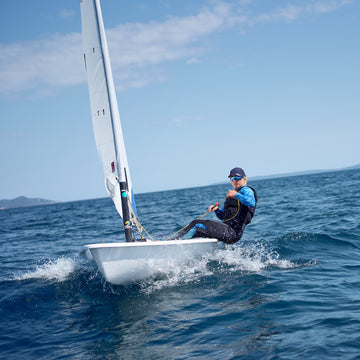
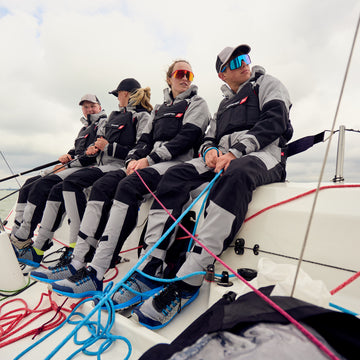
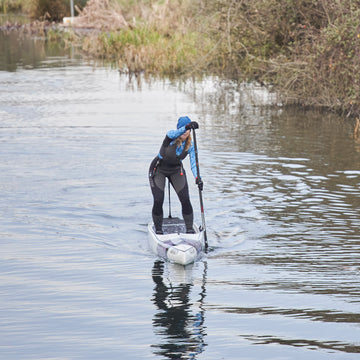
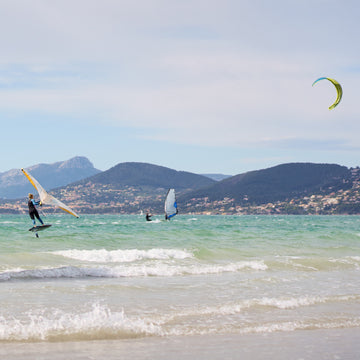
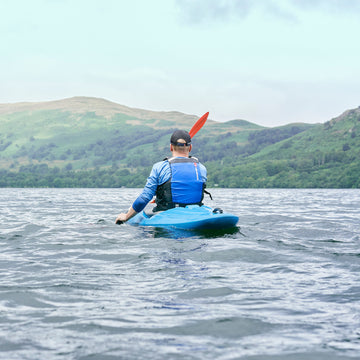
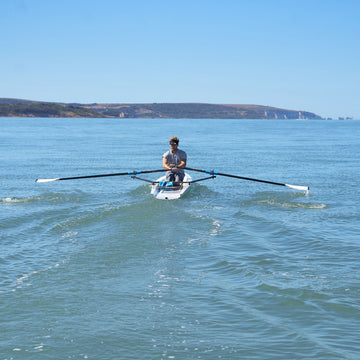
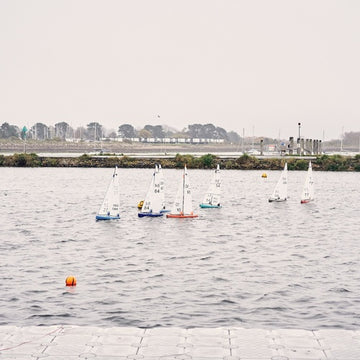
 Select Store
Select Store
 EU
EU
 US
US


